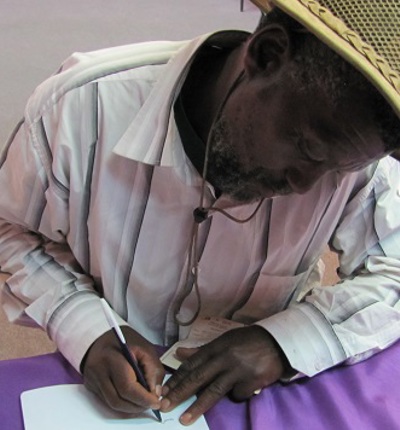
Anglo American - Silicosis
In landmark cases pursued in South Africa, Leigh Day worked with South African lawyers for 4,388 former miners against Anglo American South Africa Ltd and AngloGold Ashanti
The case was brought against these companies for failing to protect their workers from excessive dust. Silicosis, a debilitating and incurable lung disease, affects as many as 25% of South African miners. Silicosis sufferers have a much higher risk of contracting tuberculosis. Tuberculosis combined with silicosis is very serious and often fatal. Most of the claimants reside in rural areas in South Africa and Lesotho, from which so-called “migrant labourers” were recruited under apartheid, and where tuberculosis is endemic.
In September 2013, AASA agreed to pay compensation to 23 test claimants. This case, brought in conjunction with the South African Legal Resources Centre, was the first ever settlement of silicosis claims for gold miners in South Africa. The test cases were commenced in 2004 and took 9 years to conclude.
Historic settlement of South African silicosis claims – what it means for ex-goldminers
Leigh Day and South African attorney Zanele Mbuyisa then pursued a mass silicosis group claim against AASA and AngloGold on behalf of 4,365 former gold miners or relatives of deceased gold miners.
A landmark settlement was reached in March 2016 on behalf of the victims for R500 million (£23 million). The settlement vehicle that was established is called the Q(h)ubeka Trust: Qubeka was the surname of the lead claimant in the litigation, and “Qhubeka” means “go forward” in Xhosa. The function of the Trust is to medically assess the claimants and evaluate their eligibility for compensation. This settlement will first and foremost bring much needed financial relief to the victims and their families. The settlement scheme provided a model for subsequent settlement of a silicosis class action in South Africa.
Read our brochure
Former Anglo American goldminer, Alpheos Blom, discusses how settlement of his claim in 2013 changed his life
Silicosis - the Legacy of South African gold mining
Widows' story - The legacy gold mining and silicosis
Background to the settlement
As part of the landmark settlement which was agreed between 4,365 former gold miners and AASA and AngloGold, a trust was set up to process the claims and dispense compensation to claimants who satisfy specified criteria. The trust was named Q(h)ubeka, meaning ‘progress’ in Xhosa in honour of the thousands of claimants who have struggled for decades without proper compensation from the mining companies.
A total of R464 million (£21 million) was paid into the Q(h)ubeka Trust for distribution, while a further amount waspaid to assist the Trust to enable payment of ODMWA compensation to Claimants who qualify for it. In addition, Anglo American and AngloGold funded the costs of the Trust and the medical evaluations.
In order to qualify for compensation, claimants need to be medically diagnosed with silicosis and have worked on an AASA or AngloGold mine for at least two years.
The Trust arranged medical evaluations of the claimants locally to determine the existence and severity of silicosis.
Payments are based on a tariff system, which reflect the severity of disease and age of the claimant. Relatives of deceased claimants who meet the criteria are included.
Since the overall amount of the settlement is a fixed amount, the level of the tariffs depends on the number of claimants who qualify. Based on an analysis of a random sample it was anticipated that approximately 60% of the group would qualify.
In addition to payment from the Trust, the Trust will arrange for claims to be submitted to the Medical Bureau of Diseases for compensation under the Occupational Diseases in Mines and Works Act 1973 (ODMWA), which established a no-fault system to compensate miners suffering from prescribed occupational diseases.
The absence of clinics in rural areas means that most miners with silicosis have not been diagnosed and are therefore deprived of compensation. The assistance of the Trust in securing ex-miners’ ODMWA compensation is therefore vital. AASA and AGA have also promised to use their best efforts to facilitate these ODMWA payments.
The Q(h)ubeka Trustees, chaired by Doctor Sophia Kisting, are experts in the fields of occupational disease, financial administration and law:
- Dr Sophia Kisting (Chair) is National Executive Director of the National Institute for Occupational Health & National Cancer Registry (Jbg) prior to which she was Director of Global International Labour Organisation Programme on HIV/AIDS and the World of Work in Geneva. Dr Kisting was a trustee on the Asbestos Relief Trust.
- Goolam Aboobaker is a trained economist and also a trustee of the Kagiso Trust established in May 1985 as a mechanism to channel funds to promote the struggle against apartheid as well as uplift and empower communities deprived by the system. He served as Deputy Director General (and Deputy Head) of the Policy Unit in the office of President Thabo Mbeki, was a senior advisor to the IMF executive director and was Deputy Director General of the National Treasury.
- John Doidge is an attorney who is Managing Director of the Geneva Management Group. He is a trustee on the Asbestos Relief Trust.
- Alicia Kistan is a CA(SA) Shared Services Professional with experience in business process management
Silicosis is a type of pneumoconiosis which is particularly associated with dust exposure in gold mines. It is an incurable occupational lung disease caused by prolonged or intensive inhalation of tiny respirable particles of crystalline silica dust.
It is marked by inflammation and scarring in the upper lobes of the lungs. Prior to 1960, acute and accelerated variants of silicosis are said to have been common. Since then, however, the predominant form of silicosis has been ‘chronic’ silicosis, a progressive condition that usually takes at least 10-15 years to develop. 'Uncomplicated' chronic silicosis ranges from mildly symptomatic to severe. ‘Complicated’ silicosis arises where a person who has silicosis develops a further condition or ‘complication’. The most common forms of complicated silicosis are:
- ‘progressive massive fibrosis’, where silicotic nodules in the lung coalesce into massive areas of fibrosis. This occurs in approximately 5% of silicosis cases and is an extremely serious and often fatal condition;
- silico-tuberculosis, where a silicosis sufferer, whose risk of contracting tuberculosis (TB) has been significantly increased by the presence of silicosis, also contracts TB. Silico-TB is a very serious and frequently fatal condition especially if it is not diagnosed and treated promptly and effectively.
Silicosis suffers are particularly vulnerable to contracting TB. Combined with TB, the consequences of silicosis may be fatal especially if the TB is not treated swiftly and effectively.
Silicosis sufferers have a significantly increased risk of contracting TB and TB is endemic in rural labour-sending areas such as the Eastern Cape and Lesotho. This combination of factors has resulted in miners suffering from silicosis returning from the mines, contracting TB and then infecting members of their families and communities. An eminent South African medical expert describes the situation as a "river of disease flowing out of South African mines".
Miners' risk of contracting silicosis and TB continues for the remainder of their lives after they have left the mines and retired. In rural areas, where medical facilities are limited, TB is frequently not diagnosed or treated until serious permanent lung damage (or even death) has occurred. The situation has been made even worse by the fact that the forms of TB contracted include the drug resistant variants XDR TB and MDR TB.
A 2009 study by Rees and others stated: “Hundreds of thousands of men from rural areas of South Africa and neighbouring countries have come to seek work in the gold mines. They are not immigrants in the usual sense as they work for periods in the mines, go home and then return. This is termed oscillating or circular migration. Today we have serious interrelated epidemics of silicosis, tuberculosis and HIV infection in the gold mining industry.”
The study concluded that: “The failure to control dust and tuberculosis has resulted in serious consequences decades later. The economic and political migrant labour system provided the foundations for the epidemics seen in South Africa today”.
Striking parallels can be drawn between silicosis and asbestosis. Asbestosis is an occupational lung disease that is caused by the inhalation of asbestos fibres. Like silicosis it occurs with high intensity or long term exposure to asbestos. Similarly it may take many years for the symptoms of asbestosis to develop.
For over a century both the gold mining and asbestos industries have known full well of the association between dust and lung diseases and of the preventative dust control measures required to minimise the risk of these diseases. However, both industries focused on maximising profit at the expense of the workers' health, in the process of causing lung disease on an epidemic scale.
Silicosis is a type of pneumoconiosis which is particularly associated with dust exposure in gold mines. It is an incurable occupational lung disease caused by prolonged or intensive inhalation of tiny respirable particles of crystalline silica dust.
It is marked by inflammation and scarring in the upper lobes of the lungs. Prior to 1960, acute and accelerated variants of silicosis are said to have been common. Since then, however, the predominant form of silicosis has been ‘chronic’ silicosis, a progressive condition that usually takes at least 10-15 years to develop. 'Uncomplicated' chronic silicosis ranges from mildly symptomatic to severe. ‘Complicated’ silicosis arises where a person who has silicosis develops a further condition or ‘complication’. The most common forms of complicated silicosis are:
- ‘progressive massive fibrosis’, where silicotic nodules in the lung coalesce into massive areas of fibrosis. This occurs in approximately 5% of silicosis cases and is an extremely serious and often fatal condition;
- silico-tuberculosis, where a silicosis sufferer, whose risk of contracting tuberculosis (TB) has been significantly increased by the presence of silicosis, also contracts TB. Silico-TB is a very serious and frequently fatal condition especially if it is not diagnosed and treated promptly and effectively.
Silicosis suffers are particularly vulnerable to contracting TB. Combined with TB, the consequences of silicosis may be fatal especially if the TB is not treated swiftly and effectively.
Silicosis sufferers have a significantly increased risk of contracting TB and TB is endemic in rural labour-sending areas such as the Eastern Cape and Lesotho. This combination of factors has resulted in miners suffering from silicosis returning from the mines, contracting TB and then infecting members of their families and communities. An eminent South African medical expert describes the situation as a "river of disease flowing out of South African mines".
Miners' risk of contracting silicosis and TB continues for the remainder of their lives after they have left the mines and retired. In rural areas, where medical facilities are limited, TB is frequently not diagnosed or treated until serious permanent lung damage (or even death) has occurred. The situation has been made even worse by the fact that the forms of TB contracted include the drug resistant variants XDR TB and MDR TB.
A 2009 study by Rees and others stated: “Hundreds of thousands of men from rural areas of South Africa and neighbouring countries have come to seek work in the gold mines. They are not immigrants in the usual sense as they work for periods in the mines, go home and then return. This is termed oscillating or circular migration. Today we have serious interrelated epidemics of silicosis, tuberculosis and HIV infection in the gold mining industry.”
The study concluded that: “The failure to control dust and tuberculosis has resulted in serious consequences decades later. The economic and political migrant labour system provided the foundations for the epidemics seen in South Africa today”.
Striking parallels can be drawn between silicosis and asbestosis. Asbestosis is an occupational lung disease that is caused by the inhalation of asbestos fibres. Like silicosis it occurs with high intensity or long term exposure to asbestos. Similarly it may take many years for the symptoms of asbestosis to develop.
For over a century both the gold mining and asbestos industries have known full well of the association between dust and lung diseases and of the preventative dust control measures required to minimise the risk of these diseases. However, both industries focused on maximising profit at the expense of the workers' health, in the process of causing lung disease on an epidemic scale.
The Occupational Diseases in Mines and Works Act 1973 (ODMWA) established a no-fault system to compensate miners suffering from prescribed occupational diseases. It is funded by payment of levies by mining companies, calculated as a function of the total number of shifts undertaken in dusty work by the mine workforce and the dust levels on the mine. The more that is paid out in compensation the higher the levies are that the companies must pay.
The compensation paid under ODMWA system is, however, relatively small. It does not include any compensation for pain and suffering and is based on miners’ earnings at the time of their employment. Black miners earned less and were therefore entitled to less compensation. It is not uncommon for silicosis victims to have received payments equivalent to £3,000 to £4,000.
Due to the latency period of the disease, silicosis frequently develops after retirement. Miners’ are entitled to a “benefit medical examination” every 2 years to determine their entitlement to ODMWA compensation. However, the absence of clinics in rural areas means that most miners with silicosis have not been diagnosed and are therefore deprived of compensation.
A 1998 study by Trapido found that 63% of ex-miners who were found by the researchers to be suffering from silicosis had not been compensated at all.
The Leigh Day team in South Africa also found that the vast majority of prospective silicosis clients had not been through the ODMWA benefit medical examination process.
This is largely because medical services available to perform benefit medical examinations in the regions where ex-miners live in the Eastern Cape are extremely limited and local private doctors in these areas generally lack the resources, equipment, experience and willingness to undertake benefit medical examinations.
The mining industry, including AASA, is well aware of the predicament of ex-miners and their families and has been promising for at least a decade to assist ex-miners in accessing benefit medical examination facilities.
A ‘one-stop service centre opened in Mthatha in April 2014, however the extent to which this alleviates the situation remains to be seen. Certainly it will not assist the families of the large number of miners who have died in the past without being diagnosed or compensated.
Anglo American South Africa (AASA) was the head office company of the Anglo American group until 1998 when the group underwent a restructuring including the establishment of Anglo American plc and a London-based group headquarters.
AASA has been the primary focus of Leigh Day’s legal actions for three main reasons:
1. Until 1998 Anglo American was one of the largest (if not the largest) mining houses in South Africa. In its 1970 Annual Report AASA stated that ‘Group mines were responsible for 40 per cent of South Africa’s gold production, equivalent to 31 per cent of world production (excluding communist countries)’. AASA’s potential silicosis liability is by far and away the largest of any company in South Africa.
Up to 1998, there were 11 Anglo American gold mines in South Africa, spread out over Gauteng, North West Province and the Free State, in respect of which AASA was the head office company. These were:
• President Steyn, President Brand, Western Holdings, Welkom, Freddies, Free State Geduld, Free State Saaiplaas and Joel were mines in the Free State.
• Western Deep Levels and Elandsrand in the West Rand.
2. Through their extensive and integral involvement in the President Steyn litigation, Leigh Day and Mbuyisa Neale acquired a detailed knowledge of the evidence that was relevant to litigation against AASA. To that end, they reviewed hundreds of thousands of documents disclosed by AASA in the President Steyn litigation. They also engaged in detailed consultations with a range of South African and international mining and medical experts. In light of this knowledge and experience, Leigh Day and Mbuyisa Neale were confident that the case against AASA was strong.
3. AASA is a wholly-owned subsidiary of London-based multinational mining giant Anglo American plc. According to recent accounts, the Anglo American group has assets of US$21 billion (approx). Consequently, AASA’s pockets are sufficiently deep to cover its extensive potential silicosis liability.
What the media said:
Miners' silicosis win paves way for industry compensation scheme Mail & Guardian 11.3.16
Anglo American and AngloGold settle silicosis case worth almost R500m Business Day Live 4.3.16
Anglo American South Africa, AngloGold Agree on Silicosis Deal Bloomberg 4.3.16
Former gold miners to receive more than R500m in silicosis case Mining Weekly 4.3.16
South Africa gold miners' joy at silicosis settlement BBC News 26.9.13
Sick miners ask Anglo for details of defence Business Day 29.4.13
Rural idyll belies life of silent suffering Mail & Guardian 25.1.13
Time for AngloGold to take responsibility, says miners’ lawyer Business Report 5.10.12
Anglo American to face SA silicosis hearing Mail & Guardian 1.10.12
Anglo American urged to act over tuberculosis claims Guardian 18.4.12
'An incredible disregard for human life' Mail & Guardian 4.3.11
Goldminers sue for lung disease payout The Guardian 17.11.09
Gold miners to sue Anglo Observer 28.9.03

